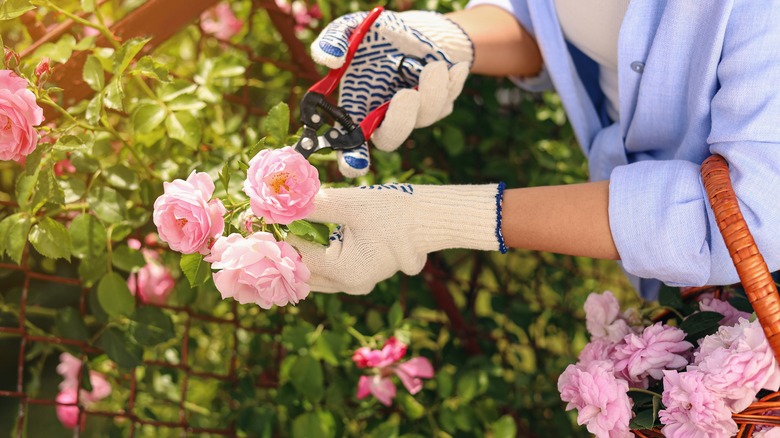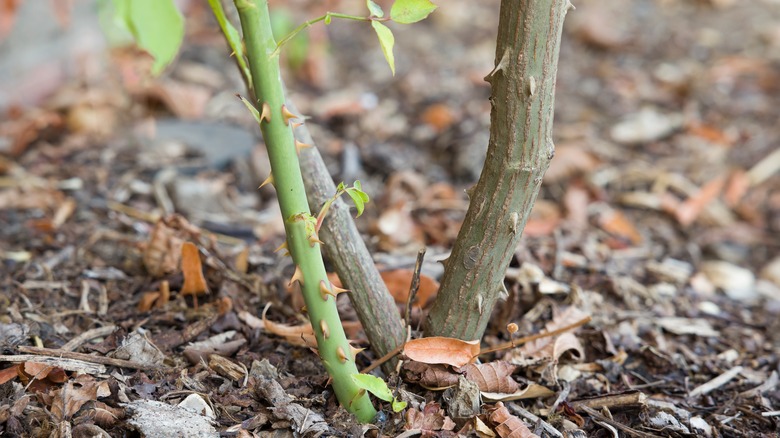How To Easily Remove Rose Suckers From Your Rose Bush
Roses are a classic beautiful flower known for being the focal point of bouquets, boutonnieres, and other aromatic arrangements. Before they make it into your flower arrangements, however, roses grow in thorny bushes, adding a touch of elegance and color to any garden. Unfortunately, due to the history of their cultivation, roses are prone to growing suckers, vigorous shoots that emerge from the base or roots of rose plants. These suckers are weedy offshoots or sprouts that grow from the underground portion of the rose bush and can drain the life from the rest of the plant.
Suckers often differ in appearance from the desirable rose stems, featuring a different leaf shape or color. These suckers usually lack the desirable characteristics of the grafted or cultivated rose variety, and if left unattended, can drain the essential nutrients from the main plant. Gardeners commonly remove rose suckers to redirect the plant's resources toward the desired growth and maintain the quality and health of the rose bush. Fortunately, for a gardener with a watchful eye, suckers can easily be removed with sharp pruning shears to preserve the main rose plant.
When and how to remove suckers
Suckers on rose plants should be removed from the main plants as soon as you identify them. Ideally, they should be removed promptly during the growing season when they are still small and manageable. It's important to monitor the rose plant regularly for the emergence of suckers, as they can grow rapidly and sap valuable nutrients and energy from the main plant.
By removing suckers early, the plant's resources can be redirected to support healthy growth and encourage the development of colorful rose blooms. Regular inspection and prompt removal of suckers will help maintain the overall health and vigor of the rose plant.
To remove suckers from rose plants, first locate the sucker at the base of the plant where it emerges from either the roots or the rootstock. Suckers can be identified through their distinctly different appearance and behavior from the rest of the plant, presenting themselves more like a climbing vine than a flowering shoot.
Use a sharp knife or pruner to make a clean cut as close to the rootstock or roots as possible. Be careful not to damage the main plant or prick yourself on thorns in the process. After removal, get rid of the suckers either by disposing or composting them to prevent them from regrowing. Regularly inspect the rose plant and repeat the process as necessary to maintain the health and appearance of your roses.
Other pruning tips for roses
Aside from limiting the growth of suckers, regular pruning of rose bushes is paramount to their health. When pruning roses, it's important to focus on creating an open structure that allows air to circulate freely, preventing the development of fungal diseases and promoting healthy growth. Remove any dead, damaged, or diseased wood. Next, prune crossing or rubbing branches to prevent them from damaging each other. Aim to create an open center by removing inward-growing branches. Additionally, thin out crowded areas to allow sunlight to reach the inner parts of the plant.
To control the height and promote bushier growth, prune your roses by cutting back the main stem by about one-third in early spring. Focus on shaping the bush to achieve a balanced and aesthetically pleasing plant. Trim back long, leggy stems to encourage lateral growth. Additionally, prune back any overly vigorous canes to maintain a compact size and prevent the rose bush from becoming too dense.
Finally, pruning plays a critical role in stimulating flower production. When roses finish blooming, remove spent flowers by cutting just above a healthy outward-facing bud. This process, called deadheading, encourages the plant to redirect its energy into producing new blooms instead of seed production. Always use clean and sharp pruning tools to make precise cuts and prevent the spread of diseases. Pruning should be done with care and consideration for the overall health, shape, and productivity of the rose bush.


